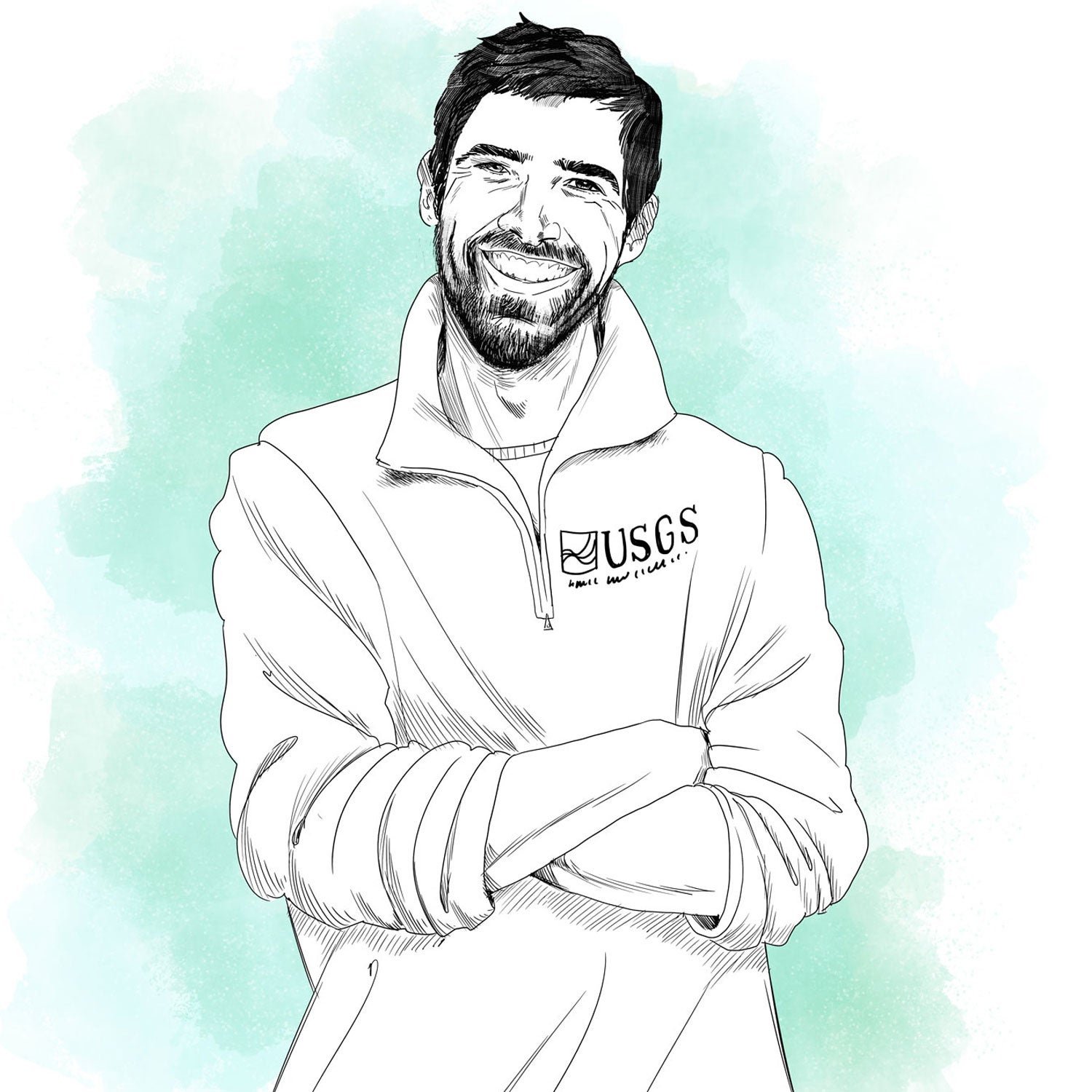Name: Michael Poland��
Job: Scientist-in-Charge,
Home Base: Vancouver, Washington
Age: 42
Education: Bachelor of Science in geology from the University of California, Davis;��Ph.D. in geological sciences from Arizona State University
Michael Poland first visited Yellowstone National Park on a family reunion camping trip when he was a boy. Little did he know that one day, he’d be in charge of studying the park’s volcanic activity and reassuring the general public that a massive eruption of the violent supervolcano beneath Yellowstone is not something we need to be actively worried about.
In 2002,��Poland started his first job as a staff scientist for the the U.S. Geological Survey at the Cascades Volcano Observatory in Vancouver, Washington.��In 2004, he was part of the team that responded to the reawakening of Mount St. Helens, traveling to the volcano to make on-the-ground observations and consult with local emergency responders. He then spent a decade working at the Hawaiian Volcano Observatory in Hawaii Volcanoes National Park. In September 2017, Poland took on a new role as the scientist-in-charge of Yellowstone Volcano Observatory. The Yellowstone Volcano Observatory is unique in that it doesn't have a main station in the Yellowstone region—instead, there's a vast array of instruments throughout Yellowstone constantly recording data that can be accessed online. A team of scientists monitors the data remotely,��led by Poland, who does his work from the Cascades Volcano Observatory in Vancouver.
With the current eruption of Hawaii’s Kilauea, Poland is helping out with response efforts there, too. We called him up just before he hopped a flight to Hawaii to talk about what the media is getting wrong about Kilauea’s eruption and why the public is so fearful of volcanic catastrophe.
On the First Thing He Does When He Wakes Up: “I check my email. You never know what’s going to be in that box. It sets the tone for the day. Ever since I took the Yellowstone job, I get questions from the general public and I see those as opportunities to talk about what we know about how volcanoes works. I make an effort to respond to everyone, because I feel that’s my responsibility as a government employee.”
On the Most Commonly Asked Question: “Usually, the question is something along the lines of, ‘Do I need to worry about Yellowstone?’ Or they’ll say, ‘I read about the —[the world's largest active geyser, which has erupted three times this spring]—should I cancel my vacation to Yellowstone?’ I say, there is a lot of bad information on the internet and a tremendous volume of conspiracy about Yellowstone. I try to explain what we know and what we don’t know. The geyser erupts, and we don’t understand why geysers are erratic. I try to be reassuring. We may not know whether or not the geyser is going to erupt tomorrow, but we know quite a bit about how the volcano works.”
On the Biggest Misperception People Have About Volcanoes: “There’s always this perception of catastrophe. That the worst-case scenario is always the one that’s going to occur. Yellowstone is a good example. Most people think if it’s going to erupt, it’s going to be a catastrophic eruption. That could happen, but lava flows are much more common. In Hawaii, people keep asking, ‘When’s the big explosion coming?’ We say, ‘There’s likely not going to be one big explosion. What we’re seeing now is what we thought was going to happen.’ People have this idea that every single event of a volcano is going to wipe out everything, which misses the fact that volcanoes display a diversity of activity.”
On Media Coverage of the Current Kilauea Eruption: “There seem��to be two things that go wrong. Media outlets or reporters take a hazard and blow it so far out of proportion��that it’s unbelievable. Then there are some people who never even look at a map of Hawaii. They think the eruption is happening in Honolulu. You end up having to do this very basic geography explanation. The entire state is taking a tourism hit right now. But now is actually the best time to go to Hawaii—the beaches in Kona are empty.”
On the Yellowstone Supervolcano: “There’s this psychology to Yellowstone that really seems to have permeated a lot of people. People really fear Yellowstone erupting and killing them. That’s very irrational—it’s like worrying about any major disaster, like an asteroid hitting the Earth. It’s a very low, low, low probability. We keep reinforcing that geysers are going to erupt and they’re erratic. They don’t erupt on a schedule. If you really want to be afraid of something, be afraid of driving your car into work—that’s far more dangerous.”
On His Favorite Volcano in the World: “One that I like, perhaps because few people know about it, is Medicine Lake, in northern California. That’s where I did some of my first big fieldwork when I was an undergraduate. I’m always happy when I’m there. It’s a low shield volcano, and it’s got interesting, young lava flows. It’s very pretty, in terms of its setting, and it has an incredible view of Shasta, another great volcano.”
On the Most Fulfilling Part of His Job: “My job is to write scientific papers and I do find fulfillment in that—I like learning new things very much. But what I like most is interacting with people. When I was in Hawaii, I was involved in the Pāhoa lava flow crisis at Kilauea [in 2014]. We were in the community, doing meetings and mapping lava flow. I never felt like what I did mattered more than when I was there. Because what I did had an extremely real application to everyone. I was able to communicate information to folks who demonstrated this amazing capacity to learn and interpret data.”
On How He Recharges: “I love playing ice hockey. There’s a rink a half mile from where I work. That’s the one thing I can do that lets me forget about everything else. For the time I’m playing, I can lose myself. If I go for a run, my mind’s always working, but with hockey, I’m totally in the zone. I’m terrible at it, but it’s fun. Hockey leaves me feeling physically exhausted but mentally refreshed.”
On the Craziest Day He’s Had on the Job: “During the reawakening of Mount St. Helens in 2004, I was flying in a helicopter around the mountain and getting dropped off to do fieldwork. This one morning, there had been a small explosion and as the helicopter was dropping me off by myself, I remember thinking, ‘If there’s an explosion, I’m going to be stuck here.’ There was this mountain goat at the end of the ridge I was working on. You hear these stories of the animals knowing when an eruption is going to happen. I don’t really subscribe to that, but it was comforting to know that goat was there.”


